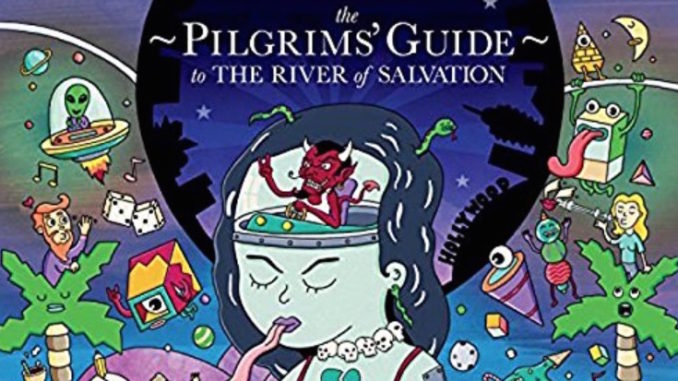
By DONNA BALANCIA
Kurt Stifle and the Swing Shift prove storytelling is not a lost art with the LP, The Pilgrims’ Guide to the River of Salvation, a “record” in the truest sense.
Where is this River of Salvation? Kurt Stifle and the Swing Shift’s latest collection could entertain that thought for years to come with its intricacy, divergent sound, and quality of music.
From the opening track, it’s easy to immediately pick up on the adoration of the 1960s-70s years held within the recording. Were things better then? In some cases no, but the listener is getting schooled regardless. The Pilgrims’ Guide is filled with incidents and accidents, encounters, tributes and new concepts. The record is made with such precise detail it’s as if it were commissioned for a time capsule.

Kurt Stifle and The Swing Shift
Kurt’s quirky and vulnerable voice is not necessarily a thing of beauty, but it has an undeniable trademark quality that blends the vulnerability of Ray Davies and the bravado of Mick Jagger. There’s an everyman appeal to the tone of Kurt’s vocals, fitting in that he multitasks on the record and produces.
The Pilgrims’ Guide to The River of Salvation provides pure entertainment from beginning to end. It presents an oddly well-blending ’60s style, mixed with folksy futuristic sound. The record is based in analog roots, and really has full effect if played on classic black vinyl on a record player.
The great thing is to be able to hold the quality pressing and look at the information provided on the album’s front and back covers. That, in itself, is something that people are learning to appreciate again, and the record offers that rejeuvenated pleasure to the culture. Those who remember, appreciate, and those who are new to the vinyl format are learning the history. The album was produced by Kurt, and Paul Roessler, who also engineered, mixed and mastered.
Pilgrims’ Guide: The Record
The record is a study in opposites on many levels, even physically. Side 1 is the “in an ideal world,” life lesson-learning side of the record, mostly all peace and love. Side 2 is ready to reach out and roar wildly.
There’s an eerie Roman warrior-sounding “Intro,” then the first song. “The Rant is Due,” with Heather Galipo’s background vocals, is a smaller scale roar, and a wordplay on the monthly worry most people have. It’s clear that this track is a warm-up for what’s possibly yet to come. (The video is a little shocking).
“Singing in the Trees” is a country-style song with tinges of Asian flavor throughout. “I spend my days alone and when I sleep, I dream about you and me singing in the trees.”
“Goodbye Laura” is an upbeat tune with cool Allman Bros. feel to it, with great lead guitar.
“Kissing Daisies” is a classic song with rhyming. Daisies were a powerful symbol in the 1960s and 1970s Flower Power times. Since there’s a follow-up daisy song, “Lazy Daisy,” one is led to believe the daisies may also represent women. Kat Arthur contributes her sultry voice to this jazzy track. This simple song becomes an avant garde big-band style track with the addition of the horn section by The Martin Brothers.

Record’s Alter Ego: Side 2
But like a pair of rivalrous twins, the Side 2 is ready to party with songs like “Swampee,” “Drugs and Alcohol,” the hard rocker “The Bottom is Black,” and the notable “Jesus Saves Blues.”
“Swampee” obviously has more than a contagious chorus; Kurt spells out the letters to the track and claims the name for himself, something there’s proabably a story behind. The video (see below) is a clever creation of socks, pipe cleaners and other household goods.
The rowdy “Drugs and Alcohol,” is a perilous story, made amusing because there are a lot of people with different pitches and tones all singing at a what sounds like a fun-sounding party. Don Bolles arranged the background vocals, which sounds like an indie music Meatloaf re-teaming with The Rocky Horror Picture Show people.

“You Only Look So Real,” is a true Kinks tribute song, with a dancy beat with a wild lead guitar, and there’s also great fuzzy 1970s freestyle jam lead on “We All Have Wings” by Rikk Agnew.
The record gives people a bunch of life lessons, but you’ve gotta work for them. So get ready to listen again and again.
And then the record even gives a feel-good sendoff with the hopeful “Love Is Everywhere.” With its uplifting chorus of children’s voices, it’s reminiscent of the 1970s rock-spiritual superhit “I’d Like To Teach The World to Sing.”
This is one for the collection, recommended for rock fans and 1960-70s lovers.

